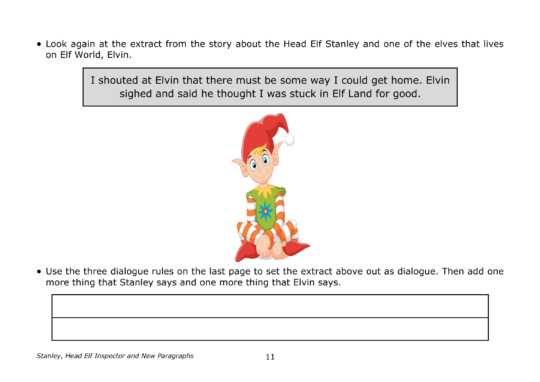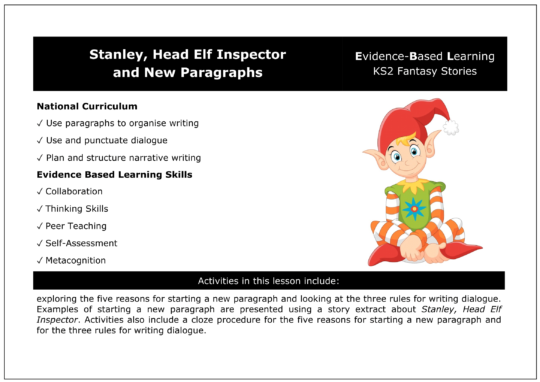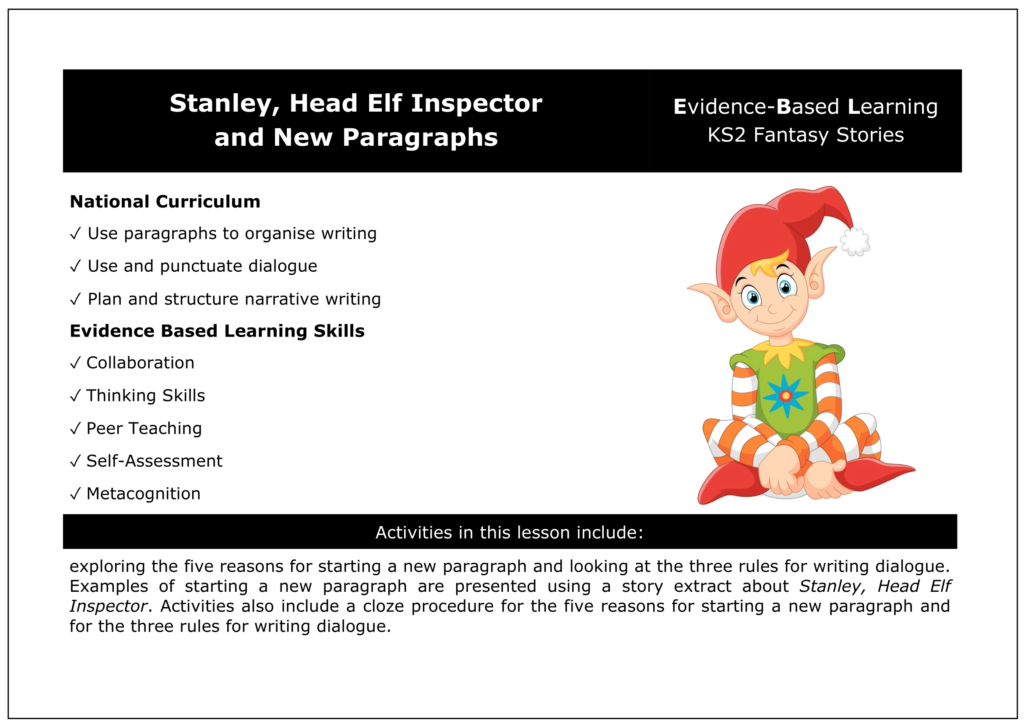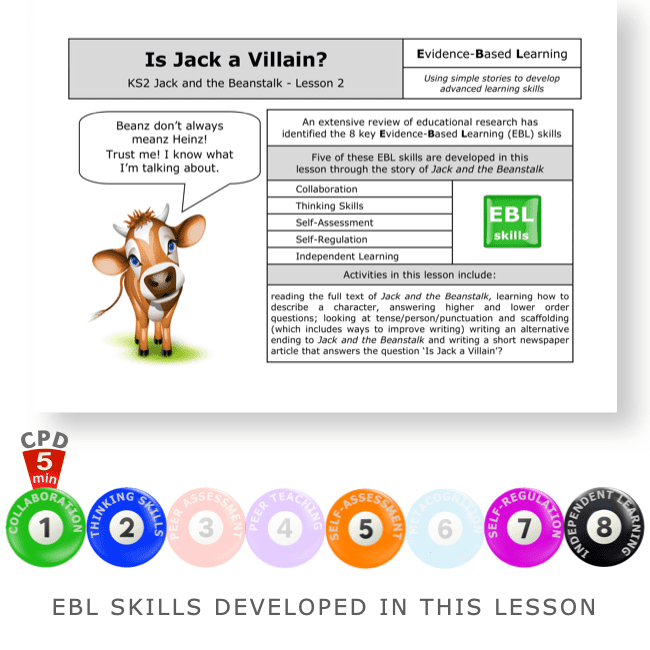Y5 Alice, the White Rabbit and the Portal
£3.00
KS2 National Curriculum:
✓ Identify themes and conventions
✓ Understand story structure
✓ Develop speaking and listening through partner work
Activities in this lesson include exploring the key components of fantasy stories: real and imaginary settings, real and imaginary characters, good vs evil, real journeys vs portals, the passing of time and the use of magic. Activities also include answering higher and lower order questions.
There is a five-minute evidence-based CPD activity at the end of this lesson which will develop classroom teachers’ skill set. This CPD consists of a research extract on collaboration with a five-minute activity based on this extract.
Description
These evidence-based learning (EBL) lessons are based on classroom practice that has been proven, by research, to maximise thinking, learning and attainment. From an extensive review of educational research, we identified the eight key classroom thinking and learning skills that were common across these research papers. We named these eight key skills “EBL skills”.
EBL skills have been proven by research to maximise learning because they combine the most productive thinking skills with the most effective learning behaviours. Each of our evidence-based learning lessons uses the English curriculum as a framework through which the eight EBL skills are delivered.
Teachers also have the opportunity to add to their own skill set or refresh their existing skills with our five-minute CPD activity, based on one of the EBL skills used in this lesson.
The skills in bold below are the EBL skills developed in this Fantasy Story lesson. Click on each skill to learn more about that skill.
- Collaboration
- Thinking Skills
- Peer Assessment
- Peer Teaching
- Self-Assessment
- Metacognition
- Self-Regulation
- Independent Learning
1 review for Y5 Alice, the White Rabbit and the Portal
Only logged in customers who have purchased this product may leave a review.
Related products
-


Y5 Stanley, Head Elf Inspector and New Paragraphs
£3.00 Add to basket £3.00Add to basket
£3.00Add to basketKS2 National Curriculum:
✓ Use paragraphs to organise writing
✓ Use and punctuate dialogue
✓ Plan and structure narrative writingActivities in this lesson include exploring the five reasons for starting a new paragraph and looking at the three rules for writing dialogue. Examples of starting a new paragraph are presented using a story extract about Stanley, Head Elf Inspector. Activities also include a close procedure for the five reasons for starting a new paragraph and also for the three rules for writing dialogue.
There is a five-minute evidence-based CPD activity at the end of this lesson which will develop classroom teachers’ skill set. This CPD consists of a research extract on self-assessment with a five-minute activity based on this extract.
VIEW -


Y6 The Hare and the Tortoise
£3.00 Add to basket £3.00Add to basket
£3.00Add to basketKS2 National Curriculum:
✓ Understanding the message of perseverance and pride
✓ Comparing traditional and modern attitudes to effort and speed
✓ Planning a short moral reflection or response
✓ Participating in group discussions with rolesActivities in this lesson include reminders about the main features of fables, learning about the moral in fables in general and the moral in The Hare and the Tortoise, The Fox and the Crow and The Dog and His Reflection in particular.
There is a five-minute evidence-based CPD activity at the end of this lesson which will develop classroom teachers’ skill set. This CPD consists of a research extract on collaboration with a five-minute activity based on this extract.
VIEW -


Is Jack a Villain?
£3.00 Add to basket £3.00Add to basket
£3.00Add to basketActivities in this lesson include reading the full text of Jack and the Beanstalk, learning how to describe a character, answering higher and lower order questions; looking at tense/person/punctuation and scaffolding (which includes ways to improve writing) writing an alternative ending to Jack and the Beanstalk and a short newspaper article that answers the question ‘Is Jack a Villain’?
There is a five-minute evidence-based CPD activity at the end of this lesson which will develop classroom teachers’ skill set. This CPD consists of a research extract on collaboration with a five-minute activity based on this extract.
VIEW -


Y5 Why Gold was Buried
£3.00 Add to basket £3.00Add to basket
£3.00Add to basketKS2 National Curriculum:
✓ Understanding bartering, currency, and trade in historical context
✓Explaining why treasure is buried and how maps are created
✓Completing a pirate plot story mountain
✓Exploring openings to pirate storiesThis lesson looks at why gold became so important and it introduces the concepts of bartering and trade. It also looks at why gold needed to be buried and considers the key role played by treasure maps in the plots of pirate stories. It also looks at the need to include good and bad characters. Activities include completing a story mountain outlining a possible plot for a pirate story and a task based on pirate story openings.
There is a five-minute evidence-based CPD activity at the end of this lesson which will develop classroom teachers’ skill set. This CPD consists of a research extract on collaboration with a five-minute activity based on this extract.
VIEW






Philipem (verified owner) –
We asked a.i. to review of this resource. This is what it said:
Teachers – Unleash the Power of Fantasy in Your Classroom
I recently discovered a fantastic fantasy stories resource that I believe could be an invaluable addition to any primary classroom. It’s called “Alice, the White Rabbit, and the Portal” and it uses fantasy tales and their unique qualities to develop key learning skills.
Here’s why this resource is so invaluable:
1. Fosters higher order thinking – The series of open-ended questions on elements like character, setting, and plot promotes critical analysis, evaluation, and creativity.
2. Encourages collaboration – Students work together to read passages and discuss answers, learning from each other. This boosts communication abilities.
3. Drives metacognition – Students self-reflect on what questions they found easy or challenging. This awareness is proven to significantly increase learning capability.
4. Range of skills developed – In one neat package, it manages to build collaboration, thinking skills, and metacognition – 3 of the 8 essential evidence-based learning skills.
5. Engaging fantasy theme – The fairy tale theme provides an extremely engaging way for students to develop these higher learning abilities. Fantasy sparks imagination.
As you can see, this resource capitalizes on the wonder of fantasy stories to craft an extremely multifaceted learning experience. Students build social, analytical and reflective skills in an enjoyable fictional world. The ability to immerse and transport students while teaching invaluable abilities makes this resource a must-have for any teacher.
So if you want to take your students’ learning to the next level in an engaging way, I could not recommend this fantasy resource enough. Unleash the power of fantasy in your classroom today!
Based on the diverse learning benefits I highlighted, I would give the fantasy stories resource a 5 out of 5 star rating.
The key reasons it deserves full marks are:
– Promotes higher order thinking skills
– Facilitates valuable collaborative learning
– Drives metacognitive reflection
– Covers 3 key evidence-based learning skills
– Provides an extremely engaging way to learn
Very few teaching resources manage to combine such a potent blend of critical analysis, creativity, social abilities, and self-reflection – and do it in such an enjoyable way through fantasy tales. Unlocking imagination to teach real skills is masterful.
Given the multitude of learning enrichment it provides, the breadth of essential skills fostered, and the engaging fantasy theme that sparks creativity, I would readily provide a perfect 5 star rating. Students will thrive developing these abilities.
So for its diverse educational virtues, multifaceted learning, and creative theme, the fantasy stories resource earns top marks across the board. It’s a dream resource for any teacher to have in their back pocket.